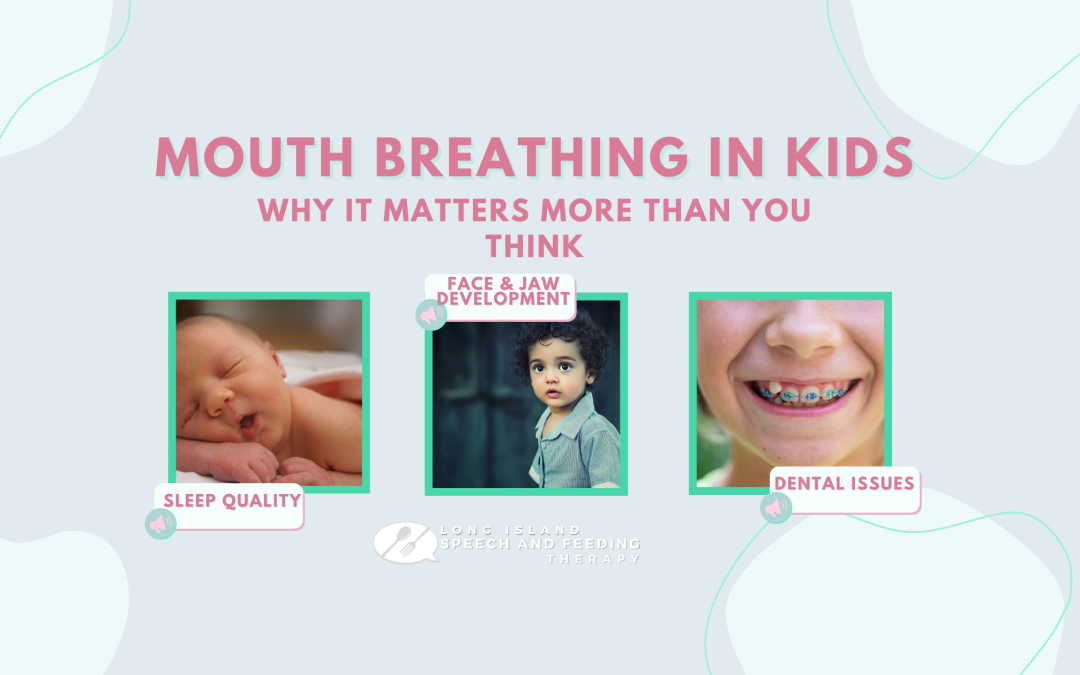As a parent, you may have noticed your child breathing through their mouth—especially during sleep or periods of rest. While it may seem harmless, chronic mouth breathing can have a significant impact on your child’s overall development. From speech and feeding challenges to sleep disturbances and changes in facial structure, mouth breathing is more than just a habit—it’s often a red flag.
In this post, we’ll explore why mouth breathing matters, the issues it can cause, and how myofunctional therapy can help.
Why Is Mouth Breathing a Concern?
Chronic mouth breathing can affect several areas of a child’s development:
Speech Development
Children who breathe through their mouths often have low tongue posture. This can interfere with correct speech sound production—especially for sounds like /s/, /sh/, /l/, and /r/. Over time, this may lead to speech delays or articulation issues.
Sleep Quality
Mouth breathers may snore, grind their teeth, or experience restless sleep. This can affect mood, memory, learning, and attention during the day. Poor sleep can also mimic symptoms of ADHD.
Facial and Jaw Development
Long-term mouth breathing can lead to noticeable changes in a child’s face and jaw. These may include a long, narrow face, recessed chin, weak jawline, and a high-arched palate. These changes are due to improper tongue and lip posture, especially when the mouth remains open at rest.
Dental Issues
Open-mouth posture can contribute to dental misalignments such as overbites, overcrowding, and malocclusions. A narrow palate and poor oral rest posture can often mean future orthodontic treatment is needed.
Behavior and Focus
Reduced oxygen intake from chronic mouth breathing—especially during sleep—can affect behavior, focus, and energy. Many children who mouth breathe may appear hyperactive or struggle with concentration in school.
Feeding Challenges
Mouth breathing is often accompanied by low oral muscle tone, which can make chewing and swallowing more difficult. It may also contribute to picky eating and oral motor delays.
How Myofunctional Therapy Can Help
Myofunctional therapy focuses on retraining oral and facial muscles to encourage proper habits. A therapy program may include:
-
Strengthening the tongue and lips
-
Teaching proper tongue rest posture (tongue resting against the roof of the mouth)
-
Encouraging lips-closed, nasal breathing at rest and during sleep
-
Supporting proper chewing and swallowing mechanics
Over time, this therapy can improve breathing patterns, enhance facial growth, and support clearer speech and better feeding skills.
What Can Parents Do at Home?
If you suspect your child is mouth breathing consistently (and not just due to a stuffy nose), here are some simple things you can try:
-
Encourage nasal breathing during quiet play, reading time, or while watching TV
-
Practice blowing games, bubbles, or straws to strengthen lips and promote oral awareness
-
Use sticker charts or gentle reminders to reinforce lips-closed posture
-
Ask your pediatrician about allergies or congestion that may be contributing to open-mouth breathing
-
Try “tongue up” exercises to help with proper oral rest posture
When to Seek Help
If your child’s mouth breathing is affecting their speech, sleep, feeding, or facial development, it’s time to consider an evaluation. At Long Island Speech and Feeding Therapy, we offer myofunctional therapy screenings to help uncover the root cause and create a personalized plan to support your child’s growth and development.
Don’t wait—early intervention can make all the difference.
Ready to learn more or schedule a consultation?
Visit www.lispeechtherapy.com or contact us today.

